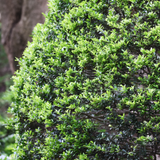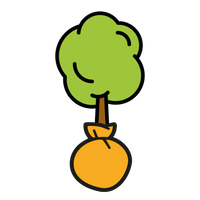Ilex Crenata̴Ì?bears̴Ì?small, dark green, glossy leaves, which are̴Ì?followed with handfuls of white flowers in Springtime, and dark (poisonous) berries̴Ì?during Autumn.
About̴Ì?Root Ball Japanese Holly Hedging
Root Ball Japanese Holly plants are only available to buy and plant during November - March, but can be pre-ordered at any time outside of the root ball season.
Japanese Holly has a very similar nature to Box hedging, but does not get leaf scorch when pruned, can regenerate from old wood, and can even adapt to colder, tougher conditions- it's the perfect alternative to Buxus sempervirens.̴Ì?
Either keep your Japanese Holly as a small, neat hedge, or try using it as a tidy border/path edging- or even grow to about 1m and trim into a topiary shape!
Key Features
Ilex crenata can tolerate difficult conditions such as shade, urban pollution, and cold climates, making it the ideal hardy natures, small hedging component to any garden.
-
Growth rate: Slow (10-20 cm per year)
-
Ideal height: 1.2m- 2.5m Medium
-
Soil type: Normal
-
Exposure: Coastal, exposed, inland
-
Aspect: Full shade, full sun
-
Evergreen foliage? Yes
Pruning & Care
When you receive your Japanese Holly Root Ball plant, it will need to be planted within a couple of weeks or so and must be well-watered during this time. Do not allow the soil to dry out- this will more than likely damage the roots altogether.̴Ì?
Japanese Holly will easily tolerate hard pruning but will be vulnerable to cold weather if done, due to new growth. You can trim off any dead branch tips to make the shape more attractive, too.
How To Plant Japanese Holly Root Balls
- If you're not ready to plant straight away, your root balls will need to be kept moist and in a cool, dark room (i.e., garage or shed). Ideally, they should be planted straight away, but can last up to 3 days or so.
- Dig a hole that is several inches wider than the root ball, but about the same depth. Soak the hole with water, and sprinkle a thin layer of RootGrow at the̴Ì? bottom, if using.
- Ensure the root ball has been given plenty of water, then put the damp root ball into the soil, and begin backfilling with soil. Check the base of the stem is level with the surface of the soil, or just under.
- Firm the soil down lightly, then give the plant a good watering.
- Like all plants, it will need to be kept free of weeds and given plenty of water- it's first year after planting is vital, as the plant needs enough resources to be able to settle down, recover, and establish.














